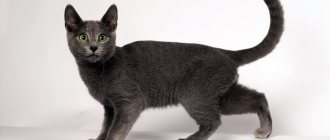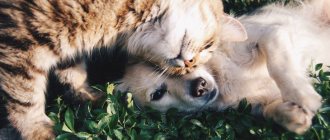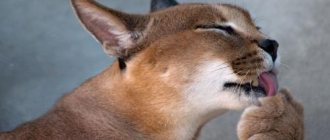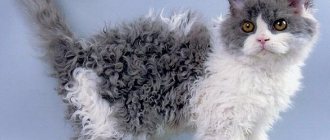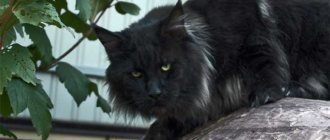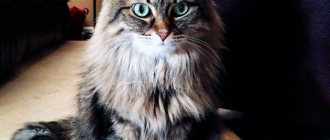A fluffy Siberian cat will become a devoted pet and the most faithful companion for people who have a strong character. He has self-esteem and his own opinion. However, the Siberian cat puts the authority of the owner first. When the owner is not in the mood, the animal will not bother you, and in moments of joy it will share pleasant moments with him.
A fluffy Siberian cat will become a devoted pet and the most faithful companion for people who have a strong character
History of the breed
It is still unknown when the Siberian cat appeared on the territory of Russia. Some scientists believe that it migrated to the Russian Federation along with immigrants from Asia. New residents brought with them animals of a very beautiful white color. Gradually, the appearance of Siberian cats changed.
Many years ago, this breed of pet was called the Bukhara cat. The breed, which is popular today not only in Russia, was formed in Siberia, so it began to be called Siberian. This region experiences mostly windy and frosty weather. Because of this, the wild representative of such an interesting breed has a fairly dense coat and thick undercoat. The forest cat, which lived in Siberia many years ago, had a huge influence on the formation of the appearance and character of animals.
Today, long-haired cats are the most common pets. They are quite successful at catching mice. Only by its presence can a white Siberian cat scare away other rodents from the house, so it is not recommended to keep lemmings and squirrels together with a representative of this breed.
Appearance and standard
According to the description of the standard, a purebred Siberian cat is distinguished by its large size, strong bones, massive build, short limbs, proportional head, and a very beautiful and expressive muzzle.
The ears are large, the tips of the auricles are decorated with fleecy tassels. Large, clear eyes have an oval shape and a clear outline. At birth, the eye color is blue. As they grow older, the color of the eyes may differ; the most common are pets with eyes of amber, copper, yellow or green.
As for the color of the coat, thanks to the efforts of breeders, Siberian cats of gray, smoky, ash, pure white, black, red, silver, tortoiseshell and tricolor colors were bred.
Gallery: Siberian cat (25 photos)
What is known about the character of cats?
As you know, Siberian cats have a rather difficult character. We can say that they are full of their own dignity, so it will be very difficult for the owner to subjugate them to his will. The innate stubbornness of the handsome red-haired man cannot be broken by training and punishment. There is no point in being overzealous with training, but rigor in the process of raising an animal will not hurt.
The wayward fluffy cat is very loyal. He chooses a leader quite quickly. The pet is loyal to its owner, and will treat all other family members with a touch of superiority. Even a small ginger cat will not spin and jump around the table, as it has elegance and poise. Only sometimes does a Siberian allow himself liberties.
Very beautiful long-haired cats love to play with toys. With their help, the owner will be able to lure the pet to the right place. In a room where there are strangers, the kitten will behave very carefully. He will not go into the guest's arms, but he will not show aggression. The ginger cat looks calm and balanced. However, she loves to explore the territory, doing so quietly, carefully and gracefully.
It is still unknown when the Siberian cat appeared on the territory of Russia
Character and habits
If you are looking for a plush cat that will lie on the sofa all day long and wait to be petted and cuddled, do not buy a Siberian breed kitten.
The Bukhara cat has amazing prudence and good nature; the animal loves affection, but prefers independence and freedom. It is difficult for Siberians to adapt to life in a closed space, but they feel great in an open area; a forest cat can walk around the yard and local area for hours. Thanks to the hunting inclinations of the Siberian cat, there will be no mice or rats in the house. Therefore, it is necessary to choose your pets wisely. It is not uncommon for a Siberian cat to bring a family pet – a small hamster or a decorative rabbit – to its owner in its teeth.
A cat of the Siberian breed, as experienced breeders note, has canine instincts, bravely protecting its home from strangers.
One of the characteristic features of representatives of this breed is to bring the owner’s things or slippers in their teeth, and give the child his favorite toy.
Choosing a pet
A gray kitten can be separated from its mother at the age of 3 months. The baby should already learn how to use a tray, lap up food from a saucer, and also have the skills to communicate with other animals. According to owners' reviews, the animal's character changes slightly. That is why you need to carefully watch how the cat behaves in the nursery. If he is happy and active, you are in luck: he will be the best pet. You should avoid buying a timid and lethargic kitten. The fact is that infantile fear is very often the cause of unsociability and aggression in older age.
Care for a pet
A very beautiful white cat is not too picky. If you follow all the rules, the animal will become the main decoration of your home, since a red or white animal has strong and thick hair, and there will be no problems with caring for it. The pet's fur does not fall out in clumps when shedding and does not gather in tangles. But you need to take care of her. It is imperative to accustom your cat to a furminator (comb-trimmer for combing out the undercoat) from an early age.
It must be remembered that a lot of dead hair will end up in the pet’s stomach while washing with the tongue. You can help your pet cope with unnecessary supplements by introducing grass and oats into the menu.
When choosing an animal, you need to find out about its vaccination, focus on the availability of health certificates and check that all documents are filled out correctly
You should not bathe your pet too often. This procedure is performed once every 10 months. If the cat regularly attends exhibitions, bathing is carried out once a month. But it is necessary to accustom your cat to bath procedures from a young age. It would be a good idea to purchase a scratching post.
How cats populated Russia. Bukhara cat
Read part 1. How cats populated Russia. Where did the cat come from?
Overseas beauties
J. Miller (Wastlehuber) cites the fact that “long-haired cats were directly imported to England from Russia.” And long-haired cats came to Russia at different times and in different ways. There is information that the first long-haired cats were brought to Russia by Byzantine diplomats, priests and merchants. At the same time, the German zoologist and botanist Peter Simon Pallas (1741-1811), who worked in Russia at the invitation of Empress Catherine II, who in 1768-1774. made a number of trips around Russia, noted that large long-haired cats were “brought to Russia by Bukhara merchants” along the Great Silk Road. Bukhara was once part of the Persian region of Khorasan, which was separated from Russia to the west by the navigable Caspian Sea. Therefore, I think we can say that N.S. Pallas points to the same large region that at the beginning of the 17th century. pointed out Pietro della Valle as the region in which long-haired cats were common. In the article “Siberian breed. Legend and reality" Tatyana Pavlova wrote that due to the fact that these cats were brought by Bukhara merchants, in Russia they were called Bukhara, and "they were quite expensive at that time and therefore only ended up in rich and noble houses" (Tatyana Pavlova , "Siberian breed. Legend and reality"). The Bukhara cat was mentioned in his notes about a trip to Central Asia by the Swedish-born composer and ethnographer Julius Napoleon Wilhelm Harteveld (1859 - 1927), who undertook this trip in 1913 to collect folklore. In his book “Among the shifting sands and severed heads. Travel Sketches of Turkestan”, published in Moscow in 1914, in the 6th chapter, called “Bukhara”, N.V. Garteveld said that he saw Bukhara cats at one of the Bukhara bazaars: “Famous and, indeed, very beautiful and graceful Bukhara cats are sold here locally, and not cheap either. Sale of kittens Cat nurseries Cat food Atlas of cat breeds
A pair of good specimens (male and female) costs from 75 to 100 rubles.” It is believed that Bukhara cats resembled Siberian cats in appearance, differing from them in their golden color. N.V. Gartveld, speaking of them as “very beautiful and graceful,” unfortunately, does not give them a detailed description. Siberian cats are indeed very beautiful, but is it possible to emphasize their gracefulness when describing them? The Siberian cat is characterized as large, muscular, heavy, with muscular limbs of medium length, a short and wide head and a rounded muzzle and chin. Even taking into account the subjectivity of perception, can an animal with such characteristics be called graceful? I think no. You can call, say, a Siamese cat or an Angora cat graceful, but not a Siberian cat. Alexander Ivanovich Kuprin (1870-1938) in the story “Yu-Yu” characterizes a surprisingly smart and dog-like devoted cat named Yu-Yu as follows: “She is proud! She never forgets that blue blood flows in her veins from two branches: the great Siberian and the sovereign Bukhara.” A.I. Kuprin describes Yu-Yu as “a large, slender, proud cat, the first beauty and the envy of lovers.” He also writes that Yu-Yu was “dark chestnut with fiery spots,” a white shirtfront on her chest, an elegant muzzle, a quarter-length mustache, yellow-green eyes and long, shiny fur. Yu-Yu had “back legs in wide pants” and “a tail like a lamp brush!” In this description, the slender physique and grace of the muzzle are explained by the presence of “Bukhara blood” in Yu-Yu. Perhaps Bukhara were the name given to colored, non-white Angora cats, which can be described as graceful. And they were called Bukhara, because they were brought to Russia by Bukhara merchants and to distinguish them from the whites, who were then traditionally called Angora. In the article “Bukhara Cat”, published in No. 11, 2005, of the journal “Science and Life”, S. Korshunov wrote about the Bukhara cat: “But where have these cats gone today? Wanting to get an answer to this question, I again resorted to literature. In the “Essay on the Nature of the Khiva Oasis” (Tashkent, 1882) it is said about local cats that “occasionally one comes across long-haired cats brought from Bukhara...” Similar brief information is found in some, but not all, descriptions of nature and local animals. Looking at the map, you can see that references to Bukhara cats in certain villages can serve as a kind of marking of trade caravan routes.” Moreover, the Great Silk Road passed through Bukhara, which was famous for its bazaars, and therefore not only local goods were sold here, but goods from all over the world, including Angora, were brought here.
The term "Great Silk Road" was coined by the German geographer Ferdinand Freiherr von Richthofen in 1877 to refer to the trade caravan route that connected the Chinese city of Xi'an with the Middle East and Europe. It was the main route along which goods, especially luxury goods such as silk, jewelry, incense, spices, dyes, carpets and many other goods from various regions of China, India and Asia Minor to the Mediterranean, were transported for thousands of years. Along this path, cultural exchange took place, and relationships were carried out between merchants, priests, pilgrims, warriors, city dwellers, and nomads throughout the continent from China to the countries of the Mediterranean basin. The length of the Silk Road reached 8,000 km, and it was used most intensively from the 2nd-1st centuries. BC. until the beginning of the 16th century. AD Thanks to the Great Silk Road, trade developed and, accordingly, the development of such great civilizations as the empires of China, Egypt, Persia, India, Arabia, Rome and Byzantium took place.
However, there were very few travelers who would complete the entire journey. In most cases, goods were transported by different merchants along a chain and resold by one merchant to another, and trade usually took place in trading areas in cities or oases. Of particular interest to us is the fact that one of the routes of the Great Silk Road turned to the northwest along the river. Amu Darya to Bukhara and Samarkand, then to the Aral Sea, then to the region of modern Astrakhan and to the Crimean Peninsula, and from there through the Black Sea it went to the Balkans and Venice. Another route crossed the Caspian Sea and went through the Caucasus and the Black Sea to Constantinople. A significant section of the Silk Road passed through the territory of Persia, which periodically underwent prosperity and decline in different centuries, and, accordingly, its territory also changed in different centuries, occupying the entire Middle East (excluding the Arabian Peninsula), Egypt and even the territories of the southeastern Europe, therefore Persian merchants played a leading role in trade along both the central part of the Great Silk Road and along the entire Route, as the main intermediaries. It is important for us to note here that the areas where, according to documented evidence, travelers saw long-haired cats, were part of Persia in different centuries.
War of mice and cats
The fact that for mice “there is no beast worse than a cat” has been known since time immemorial.
It was because of this that ancient sailors took cats with them on ships, since rodents not only destroyed food supplies on ships, but also damaged ropes and wooden parts of the ships themselves. How can one not recall here the legend that, at Noah’s request, God specially created a cat so that it would destroy a mouse that intended to gnaw through the bottom of the Ark, and thereby save Noah and his family. It is believed that the first cats came to Europe on Phoenician trading ships in the 9th century. BC. Rodents have been a big problem in households since ancient Egyptian times. Mouse and rat holes have been discovered by archaeologists in almost all ancient Egyptian buildings, as have ceramic rat traps. This explains the great popularity of the use of cats in rodent control in ancient Egyptian society, which was reflected in the art of Ancient Egypt. One of the widespread subjects in art is the “War of Mice and Cats,” scenes from which are depicted on numerous ancient Egyptian ostracons (clay shards) mainly from the New Kingdom period of the 16th – 11th centuries. BC. and papyri, on one of which, kept in the Egyptian Museum of Turin, the Mouse King on a chariot leads hordes of mice attacking a fortress, which is defended by cats asking the mice for mercy. The author of books about Ancient Egypt, H. Wilson, believes that this papyrus contains a symbolic message of warning about what happens when the balance in the universe, which the ancient Egyptians called “Maat,” is upset. In subsequent centuries, this plot was reproduced in the art of many nations, including Russia, where it became one of the favorites in Lyubka culture. However, as history shows, people often forgot that in the fight against various rodents, a more faithful ally than a cat does not exist even today. In medieval Europe, the Catholic Church and the Inquisition, in pursuit of witches, carried out public and mass executions and torture of cats. As a result of the massive extermination of cats in Europe, their numbers sharply decreased, which led to the fact that the breeding mice destroyed food supplies on such a scale that it led to famine in some areas. Thus, at the beginning of the 16th century, rats almost completely ate the harvest in Burgundy, which caused famine and death. But this was not the only or worst consequence of the persecution of cats. In the Middle Ages, gray rats (Rattus norvegicus) began to penetrate from Asia, carrying the bubonic plague and other diseases. China is believed to be the homeland of gray rats. They settled from there at first relatively slowly, only around the 1st century. BC. era they penetrated the Hindustan Peninsula. But with the development of navigation, their settlement began to accelerate. In the 7th – 15th centuries. From India, on the ships of Arab sailors, gray rats were brought to the ports of the Persian Gulf, East Africa and the Red Sea, and in the 15th – 16th centuries, when trade with India began to develop, the settlement of gray rats began to acquire alarming proportions. In 1727, a real invasion of gray rats began in Europe. Gray rats are quite large rodents, the body length of which without a tail reaches 25 cm, and their weight is 550 g. For this reason, local European short-haired domestic cats, which were relatively small in size, were not hunted, which means there was a need for larger ones. and strong domestic cats to fight against rodents. In Islamic countries, for the same reason, the cat trade was widespread. Arab scientist of the 9th century. Al-Jahiz, the author of The Book of Animals, cited the story of another Arab author, Al-Sindi ibn Shahak, who condemned cat dealers for deceiving customers. Passing off stray feral and possibly small wild cats as tame, so that the behavior at the time of purchase would not reveal their true origin, and the cats would sit quietly, traders rotated the cats in closed jugs to make them dizzy. The Arabic names of long-haired cats have survived to this day: “sennawr širāzi” or “ket shiraz” (qeṭṭ širāz) - which translates as “cat from Shiraz”, “ket ankara” (qeṭṭ anqara) - “cat from Ankara” ", "ket halabi" (qeṭṭ halabi) - "cat from Aleppo." This variety of names rather reflects the desire of cat dealers to present their product as rare and exotic, brought from afar. The earliest mention of trade in Angora cats in Europe dates back to the beginning of the 15th century. It is said that the first chairman of the High Court, Jean de Popincourt, at the Lendit fair in the Paris suburb of Saint-Denis, bought large cats covered with thick fur from Armenian merchants to fight rats. It was also reported that merchants said that these cats, which appeared "in Noah's Ark when the lion sneezed", were called "Angora cats" and were brought from Turkey. In addition, it cannot be ruled out that when moving from Persia to Russia, many families of merchants from New Julfa, who were former residents of the Van region, brought with them their domestic cats, which were distinguished by their large size and long flowing hair. So, in the period from the 14th century, when an Armenian colony appeared in Kazan, until the 18th century, when Empress Elizabeth II ordered the best cats to be brought from Kazan to protect the imperial palaces from rats and mice, cats with strong bones, among which there could be long-haired, there should have been large numbers in Kazan, which is confirmed by the decree of the empress. Zarine Lorentsovna Arushanyan
Read part 8. How cats populated Russia.
"Trophy" cats Cats
History of the origin and distribution of cats
How cats populated Russia. Bukhara cat
Walking and feeding the animal
Since the character of the representatives of this breed was formed in the process of mixing a variety of types of wild and domestic cats, modern Siberians have wild habits. In order for your pet to throw out a large amount of accumulated energy and not lose the gift of a hunter, he needs regular walks. Before going outside, you should put a special tick and flea collar on your pet.
If you live in an apartment, you need to walk with your kitten outside together. It will be much easier to walk your pet if you live in a private house. You can fence off part of the lawn near the house and let the animal out there. After the cat gets used to its new place, you can expand the walking area. There is no need to worry if your cat is walking alone, as she will definitely return home.
It should be remembered that cats of this breed are not afraid of the cold. They can walk outside even in severe frosts.
A pet that has not been spoiled as a virgin will eat absolutely any food. You can offer him the most ordinary human food. However, the diet must contain special dry mixtures that will help maintain the appearance of the animal’s coat.
Several times a week it is recommended to give your pet goat milk, meat, quail eggs, and fermented milk products. It wouldn’t hurt to take a complex of vitamins several times a year, which an experienced veterinarian will select for him.
“Bukhara” cats have been known at least since the 16th century
Siberian cats are considered real Russian beauties.
Their expressive eyes, chic silky “fur coat” and friendly character have long won the hearts of many cat lovers... What other features does this beautiful breed have and how to care for it? To distinguish this breed from others, you need to pay attention to the following features:
- Body type . Proportional, medium length, but very strong and muscular. The bones are powerful, the tummy is firm, the neck is short, but quite massive.
- Head . Large in size, round and trapezoidal, ears widely spaced and with rounded tips. The eyes are oval and can be green or yellow.
- Tail . Luxurious, unusually fluffy, wide and long, covered with very thick hair, the color of which does not differ from the rest of the coat color.
- Limbs . Quite strong and powerful, not very long, with neat oval legs. Hair grows thickly between the toe pads.
- Wool . Medium length, water-repellent. The color can vary from very light to very dark. Silky to the touch.
This breed, with its average build, is quite large - the weight of adult males can reach 12 kg, smaller females - up to 7 kg. But they only gain weight by the age of five.

